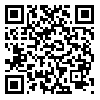BibTeX | RIS | EndNote | Medlars | ProCite | Reference Manager | RefWorks
Send citation to:
URL: http://tbj.ssu.ac.ir/article-1-2105-en.html
Abstract
Introduction: Textile industry is regarded as one of the largest producers of dye and organic compounds, and Methylene Blue is the most commonly used dye material. In the present study, peanut shell powder was used as a low-cost adsorbent for removal of Methylene blue dye from aqueous solutions.
Methods: In this experimental study, effect of operating parameters including pH (2-12), reaction time (5-210 min), adsorbent dosage (0.1-1 g/l) and initial dye concentration (10-120 mg/l) were assessed on dye removal from synthetic wastewater. Moreover, the adsorption behavior of dye was evaluated by Freundlich and Langmuir isotherms.
Results: Maximum removal efficiency of methylene blue was achieved at optimal pH of 11, reaction time of 75 min, adsorbent dosage of 8 g/l and initial dye concentration of 10 mg/l. With increasing dye concentration from 10 to 100 mg/l, removal efficiency was decreased from 99.5% to 96.46%. The obtained data demonstrated that adsorption process of Methylene blue using peanut shell powder was well fitted with Langmuir isotherms (R2=0.894).
Conclusion: Based on the results of the current study, the peanut shell seems to have an appropriate ability in Methylene blue dye removal from aqueous solution, and textile industry wastewater.
Received: 2016/05/16 | Accepted: 2016/05/16 | Published: 2016/05/16
| Rights and permissions | |
 |
This work is licensed under a Creative Commons Attribution-NonCommercial 4.0 International License. |





